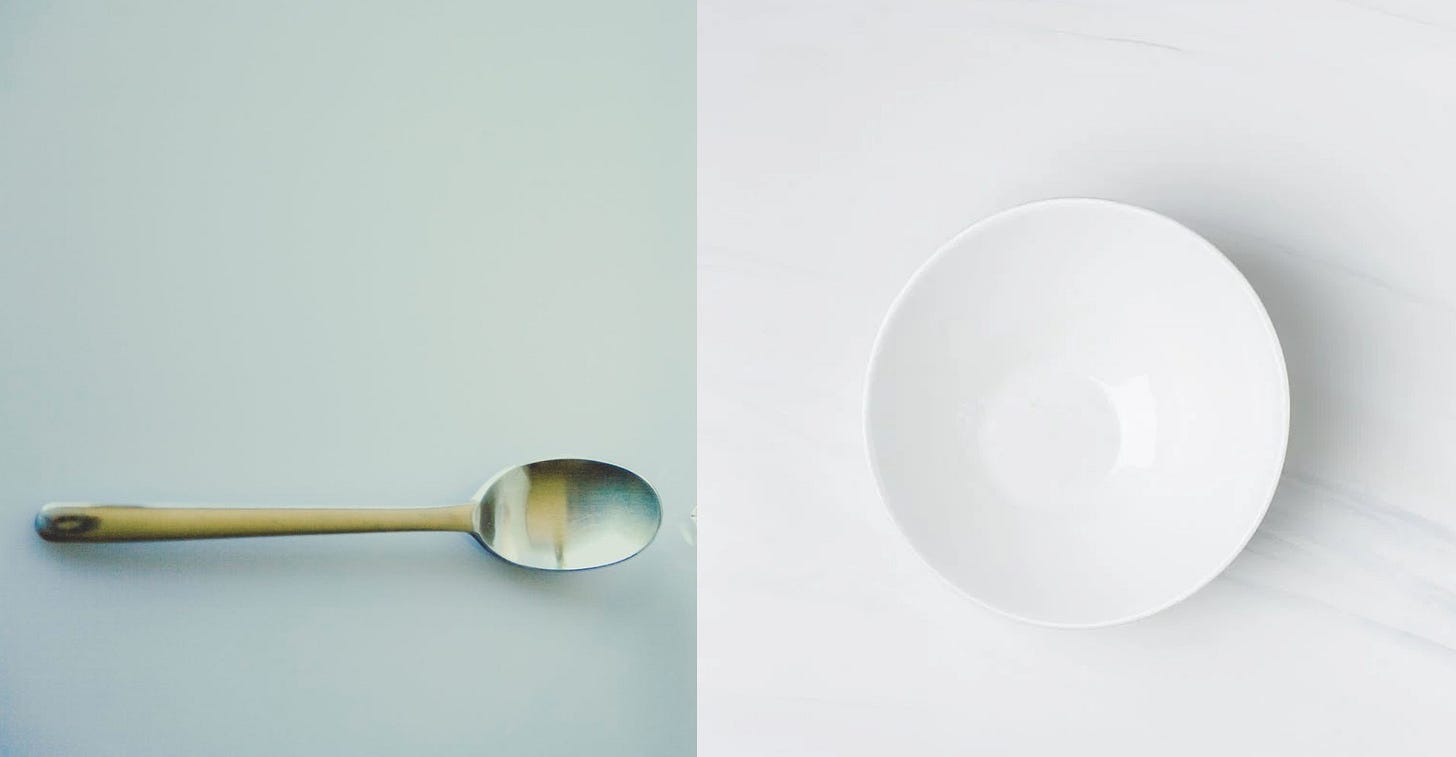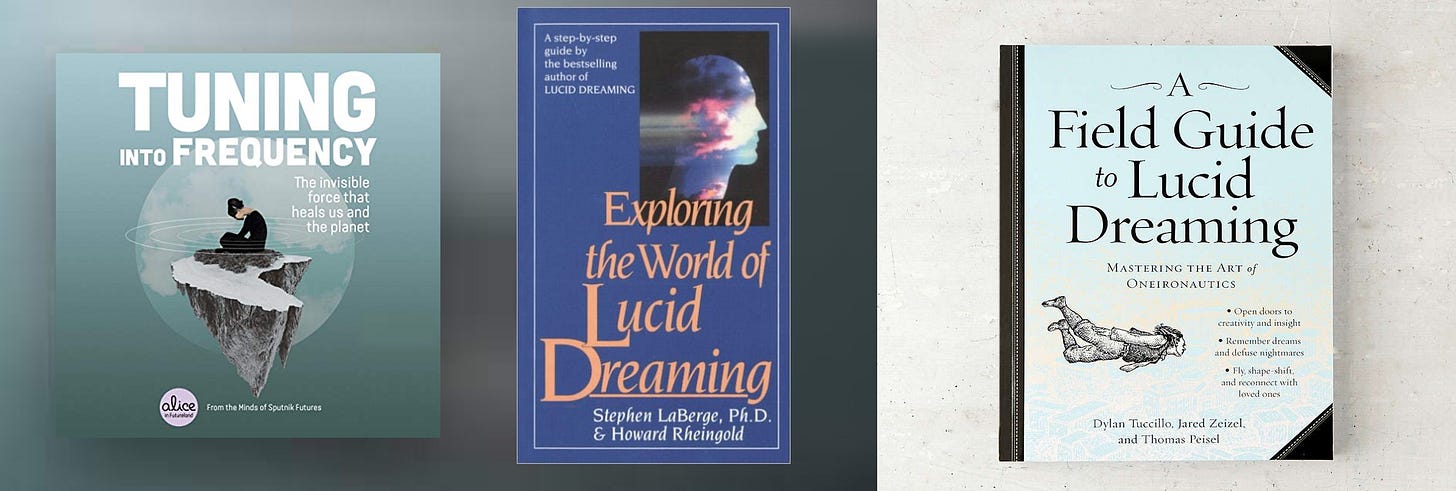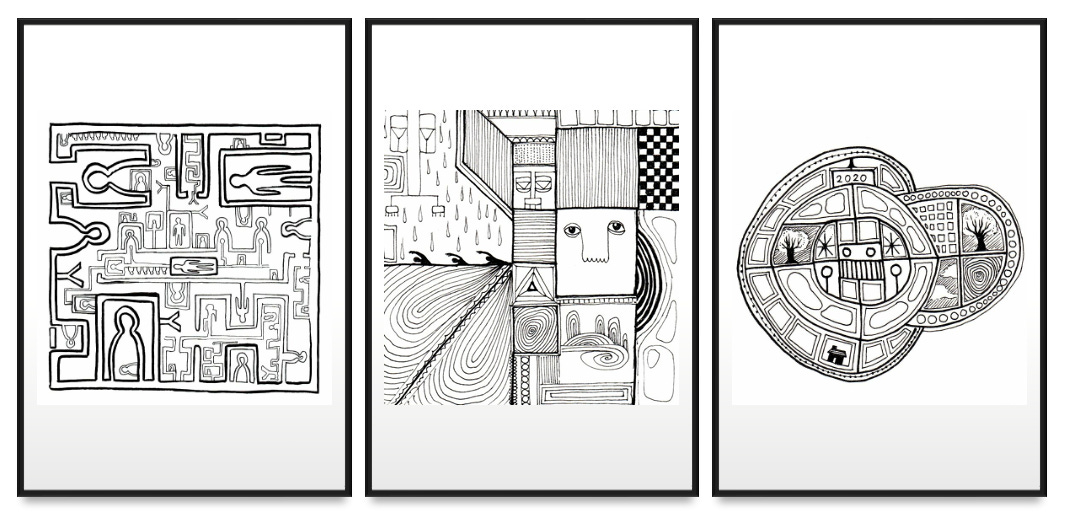🍄 Can We Engineer Our Dreams?
Watch for dream tech to pop in the 60,955 million sleep tech device sector fueling the $2.08b global mindfulness market. REM on.
Exploring every rabbit hole there is. For more wanderings, become an Alice in Futureland subscriber—it's free.
🍄 AudioDose: this is Alice on Sonic Mushrooms. Dream on here.
Hello, we’re Alice and we are always in a state of wander. Lucid dreaming? I’ve got this. From Alice’s Adventures in Wonderland to The Matrix and Inception, the dream realm holds us hypnotic. While Native Americans used dream sharing to guide communities, culture shifts today to TikTok, with Gen Z submerged in #dreamcore and #scripting trends in attempt to #shift into pre-designed dreams. And it’s not as out there as it sounds. Because back in the real world, neurophysiologists study ways we can direct the content of our dreams, even using this special sleep state to navigate nightmares, help bodies to heal and treat PTSD.
Being able to fly, conjure story plots, practice public speaking or sing with sonic perfection? I could do it in my sleep.
Please Don’t Wake Me, No Don’t Shake Me
Did you know that the brain you go to sleep with every night is not the same as the brain you wake up with in the morning? The idea that our brain shuts down when we sleep is far from the truth. Sleep helps make our memories stronger by combining them so we can retrieve our memories later. Several researchers have found that sleep picks out the emotional details and reorganizes memories, to help you produce new and creative ideas. Forming lasting memories depends on an interaction between glial cells and brain waves that are produced during sleep, and those unusual waves of rhythmic neural activity are especially active during non-REM (Rapid Eye Movement) sleep.
It’s a magic carpet. It can take you anywhere to any imaginable possibility.’
- Dr. Stephen LaBerge, Founder, Lucidity Institute.One active state of sleep is lucid dreaming, which is exactly as it sounds. “It’s a dream where you become aware of the fact that you're dreaming while you're still asleep,” Michelle Carr, a sleep researcher at the University of Rochester in New York, tells ALICE. “You notice something bizarre in the dream and question it for a second. You think this is real, this is really happening to me right now? And then you realize, ‘No, this is a dream, I'm dreaming.’ And that's the extent of becoming lucid.”
Enter Sandman
The release of sci-fi film Inception [2010], likely launched our ongoing fascination with consciousness, memory and dreaming. Modern tools of neuroscience make it easier than ever to examine this behavior, which happens during the hybrid-REM (Rapid Eye Movement) state. But what is it, and how does one go about doing it?
What is Lucid Dreaming?
Lucid dreaming is when the dreamer is conscious, to some extent, of dreaming while actually participating in the dreaming process. Dr. Berit Brogaard, D.M.Sci. lists four different levels of lucid dreaming in her Psychology Today column, The Superhuman Mind:
1. Knowing that you are dreaming.
2. Being able to control your own dream actions in a wake-like fashion.
3. Being able to manipulate your dream surroundings.
4. Being able to manipulate the dream actions of other people in your dreams.
A lucid dreamer and an ordinary dreamer have one behavior difference, suggests Brogaard: A lucid dreamer actively uses conscious controls in the prefrontal cortex while the rest of his brain is in a dream-like state. An ordinary dreamer, meanwhile, is not actively using any part of their brain during dreams.
Recent epidemiologic studies demonstrate spontaneous lucid dreaming to occur at least once in life in 51–55% of the human population.
Lucid Dream Your Way to Self-improvement
A large proportion of people diagnosed with Post Traumatic Stress Syndrome (PTSD) encounter vivid nightmares, which force them to revisit original trauma. Sleep scientists such as Brigitte Holzinger, director of the Institute of Consciousness and Dream Research in Vienna, hope to unlock lucid dreaming as a means for treating nightmares by developing ‘dream empowerment’ skills for people working through PTSD. This has opened up potential theories to treat psychiatric illness and trauma too.
Outside of the lab, people learn to lucid dream as a tool for self-improvement, fulfillment, and actualization. Sleep Junkies reports that lucid dreaming can:
• Offer you the chance to explore or live out fantastic experiences
• Help you learn and develop new skills
• Bolster your confidence
• Give you the power to overcome past ‘programming’ or other sources of anxiety (such as performance stress)
• Conquer deep-seated phobias
How to Lucid Dream
You have to do the dream work. Studies show that a combination of three cognitive techniques increases the likelihood of lucid dreaming. Dream engineer Michelle Carr explains:
1. Reality Checking: This involves asking yourself repeatedly throughout the day whether you’re currently dreaming. The idea is for the habit to spill over into sleep where, upon asking yourself the question, you realize that the answer is: ‘Yes, this is a dream!’
2. Wake-Back-to-Bed (WBTB): Set your alarm for a few hours before you’ll actually get up, and stay awake for around ten minutes. (This increases cortical activation in the brain areas implicated in lucid dreaming.)
3. Mnemonic Induction Lucid Dream (MILD): While awake during the WBTB process, rehearse a dream, while repeating a phrase in your mind such as: ‘The next time I’m dreaming, I’ll remember that I’m dreaming.’
Get a Spoon and Plate ready: Lucid Dream Exercise
“You can sit in like a comfortable chair but hold a spoon or something in your hand over like a plate on the ground. So as soon as you fall into sleep, you'll drop the spoon and it will make a noise to wake you up.”—Michelle Carr, dream engineer and researcher
Michelle Carr took ALICE through an exercise you can do anytime for a creative boost. How? By practicing the sleep onset state—that moment when you are not falling fully into a nap, but just allowing yourself to kind of dip in and out of sleep. You can use that dozy time during the day for creativity.
🎧 listen here or 👁🗨 watch here.
Leading Indicators
🧠 It’s the dream scenario.
The Lucid Dreamer app allows you to control your dreams with unlimited potential. Just stick on the electrodes, choose your Dream settings from the phone app and drift off to sleep. Lucid Dreamer does the rest. Soon you’re awake but this isn’t reality – it’s your sub-conscious universe.
🧠 Sleeping Duty
As scientists at the MIT explore Virtual Reality and the application of other sensory stimulation technologies to the area of sleep and dream engineering, they have to consider the ethics of a world in which targeted dream direction and sleep manipulation are possible.
🧠 Red Pill or Blue Pill
Or should I say, drink me. Research suggests that a pre-sleep dose of galantamine—an enzyme inhibitor typically used to treat Alzheimer’s disease—can stimulate lucid dreaming. A double-blind, placebo-controlled, crossover study combined different doses of the drug with the WBTB and MILD techniques.
🧠 Dreamtopia
The Monroe Institute in Virginia is the world leader in human consciousness exploration. Lucid Dreaming programs led by international trainers Luigi Sciambarella and Thomas Hasenberger, guide you on an experiential journey into what they call “the portal of dream consciousness.” Dream on.
🧠 Total Recall
An international collaboration of researchers in Germany, the Netherlands, France, and the United States conducted a proof-of-concept study that showed "real-time dialog between a dreamer and experimenter" is possible. The experimenters used the gold-standard eye signal method to identify that the participant was lucid within a REM sleep dream...and, "Hello (dream) world!" they communicated with the dreamer. Messages included softly spoken math problems, to which the dreamers counted their response with specific numbers of left-right eye signals. Once awake, some dreamers remembered some of the math problems.
Books we love
📘 “Imagine being able to fly. Walk through walls. Shape-shift. Breathe underwater. Conjure loved ones—or total strangers—out of thin air.” A Field Guide to Lucid Dreaming by Dylan Tuccillo, Jared Zeizel, Thomas Peisel shows you how to summon the power of lucid dreaming and more. (Workman Publishing Company 2013)
📘 Exploring the World of Lucid Dreaming goes far beyond the confines of pop dream psychology, establishing a scientifically researched framework for using lucid dreaming. Based on Dr. Stephen LaBerge’s research, this practical workbook will show you how to use your dreams. (Ballentine Books 1991)
📘 “When we are asleep in this world, we are awake in another.” Alice in Futureland’s Tuning into Frequency explores (among many things) the Mind Field, synchronicity, consciousness and the lucid dream state. (S&S/Simon Element, 2021)
What else we are wandering
🔍 🎨 Fresh from the dream
Dave Green is a London based artist who creates simple line drawings in his lucid dreams which he re-creates upon waking up. Lately he has been experimenting with giving his pen and paper to other people in his dreams to see what they create. His art has been featured in BBC Science Focus and he has lectured about his work at the Tate Modern.
🔍 🎵 "Let it be"
From the Beatles and Florence and the Machine to Jimi Hendrix and Sting, music artists have woken with melodies and lyrics from their dreams. Paul McCartney said he woke from a dream one night in 1963 and played "Yesterday" and conceived “Let It Be" after a message in his dreams. McCartney told James Corden in “Carpool Karaoke,” that during a stressful time with the band, his deceased mother Mary came in his dreams and she told him, “It’s going to be okay, just let it be.”
🔍 💤 Do you know your Sleep Age?
Like you know your credit score (or not), there are many metrics that help predict your health risk. Now, Stanford Medicine researchers have described another telling metric -- one that can predict mortality. It's called sleep age.
Sleep age is a projected age that correlates to one's health based on their quality of sleep. If you analyze the sleep characteristics of dozens of 55-year-olds and average them out, you'll have an idea of what sleep looks like at that age. For instance, someone who's 55 and sleeps soundly through the night with good quality REM cycles could, theoretically, might have a sleep age of 45.
Craving more?
📘 Alice in Futureland books
🎧 Alice in Futureland Podcasts
🎧 Benefits of Lucid Dreaming with Michelle Carr, dream engineer & Dr. Stephen LaBerge, psychophysiologist specializing in the scientific study of lucid dreaming (from the archives)
🎧 Creativity, Consciousness and Lucid Dreaming with Michelle Carr, dream engineer & Dr. Stephen LaBerge (from the archives)
🎧 Dream Yourself Well with Michelle Carr & Dr. Stephen LaBerge (from the archives)
👁🗨 Practice Your Sleep Onset State with Michelle Carr, dream engineer
Thanks for tuning in.
For more wanderings, become an Alice in Futureland subscriber—it's free.
Invite your friends to this mad tea party and let's see how many things we can learn before breakfast.
©2023 Alice in Futureland









